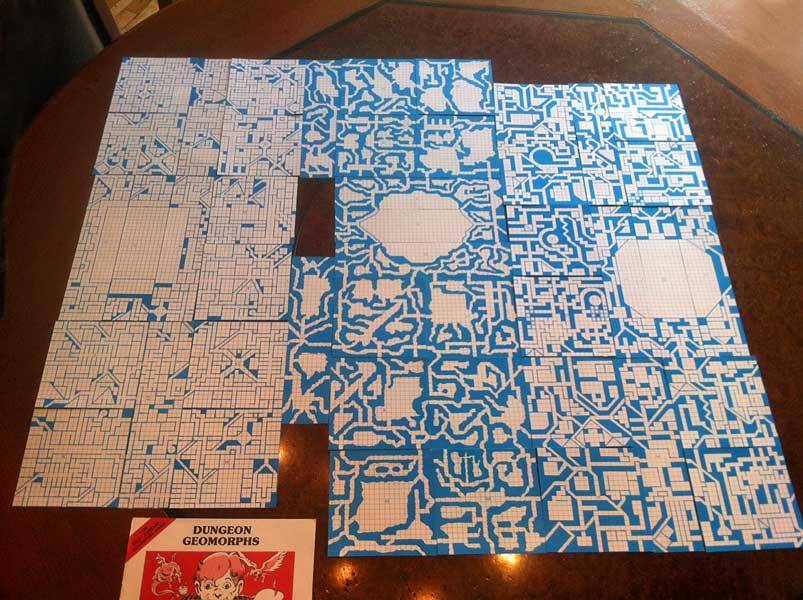 I first encountered Geomorphs with the 1978 boardgame “The Sorcerer’s Cave”. I can’t recall that much about the game itself, but the vision of a cave system formed randomly be the placement of tiles always intrigued me – though the realisation
of them in this game is very simplistic.
I first encountered Geomorphs with the 1978 boardgame “The Sorcerer’s Cave”. I can’t recall that much about the game itself, but the vision of a cave system formed randomly be the placement of tiles always intrigued me – though the realisation
of them in this game is very simplistic.
I don’t think I saw anything about Geomorphs again until resurgence of interest about them in the last few years on the internet.
In 2013 the PCs in my D&D game needed to destroy an artefact, so set off in search of “The Juggernaut of the
Eternal Labyrinth”. I'm not about to design an infinite labyrinth, and pure mazes are very boring, and my experience of random dungeon generation has been that they’re not that good, so I settled on a Geomorph solution. Simple Geomorphs
with a single exit on each side provided a suitable “labyrinth” feel. I made nine Geomorphs and laid them out randomly on the printer/scanner, printed them out, trimmed to size to form a larger Geomorph and repeated:
Combined with a random encounter table, and suitable appearance of the Juggernaut it worked very nicely.
Gary Gygax appears to have invented Geomorphs in 1976, but the concept didn't appear to take off. I'm not sure when Geomorphs resurfaced - there is a 1998 TSR product TSR9556 “Dungeon Builder's Guidebook” with 78 Geomorphs but they seem to have lost the plot completely and don't even seem to fit together. In 2004 Goodman Games released “Dungeon Crawl Classics #9: Dungeon Geomorphs” which are proper Geomorphs, quite large (14 x 19) with 2 connectors on each side.
In 2009 Dyson started his own Geomorph challenge using 10 x 10 Geomorphs with 2 exits on each side. I'm not sure if he originated this format, but this became the de facto standard. Because they're square they can be rotated, and reusing this standard enables Geomorphs from different authors to be used interchangeably.
When my son started DMing OD&D this year he was intrigued by the Gygax originals, and I was surprised to find that they were quite different to the modern concept.
Like todays standard, the originals are square so can be used "in any position (not necessarily "right-side up")", but they are larger (21 x 21) and have three connector points on each side, but one of them is typically missing. This means that there is always one connection between Geomorphs, but in a varied position.
I got to wondering about resurrecting this concept, then realised that a 15 x 15 Geomorph with 3 connectors on each side could work. If you lay out 4 of these as a square, they would match a 3 x 3 square of the standard variety, hence would be compatible. With the larger size, you could place chambers or other features off centre. Furthermore, in a larger size there is space for dead ends to lead to features.
So the template would be 15 x 15 square, with 3 connectors at the 3, 8, and 13 columns and rows. To start you off, roll d4 for each side to see if the dead end is left / centre / right / no dead end. If you get a dead end in two adjacent corners, you join them together. When you go down a connector, 3/4 of the time it will go through, 1/4 of the time it will be a dead end.
So the plan would be to mix and match the two types of Geomorph, say put in a vertical or horizontal strip or an embedded section of the other sort. This would break up the repeated pattern of the connectors.
I got to wondering about resurrecting this concept, then realised that a 15 x 15 Geomorph with 3 connectors on each side could work. If you lay out 4 of these as a square, they would match a 3 x 3 square of the standard variety, hence would be compatible. With the larger size, you could place chambers or other features off centre. Furthermore, in a larger size there is space for dead ends to lead to features.
So the template would be 15 x 15 square, with 3 connectors at the 3, 8, and 13 columns and rows. To start you off, roll d4 for each side to see if the dead end is left / centre / right / no dead end. If you get a dead end in two adjacent corners, you join them together. When you go down a connector, 3/4 of the time it will go through, 1/4 of the time it will be a dead end.
So the plan would be to mix and match the two types of Geomorph, say put in a vertical or horizontal strip or an embedded section of the other sort. This would break up the repeated pattern of the connectors.
As a proof of concept I've done 12 quick 1" square Geomorphs with a felt tip pen, scanned and inverted them, and then plugged them into a bit of javascript to lay them out randomly. If this page gives you a "secure content warning" that's it complaining about the javascript. Reloading the page will give you a different version of the random Geomorph dungeon below.
I like them - the dead ends seem to work OK, and the repeated pattern is obscured - so I think I'll do some proper ones. One thing I've learned is - if it took that long to create sketch Geomorphs, I think it'll take a bit of time to create 12 proper ones!


No comments:
Post a Comment